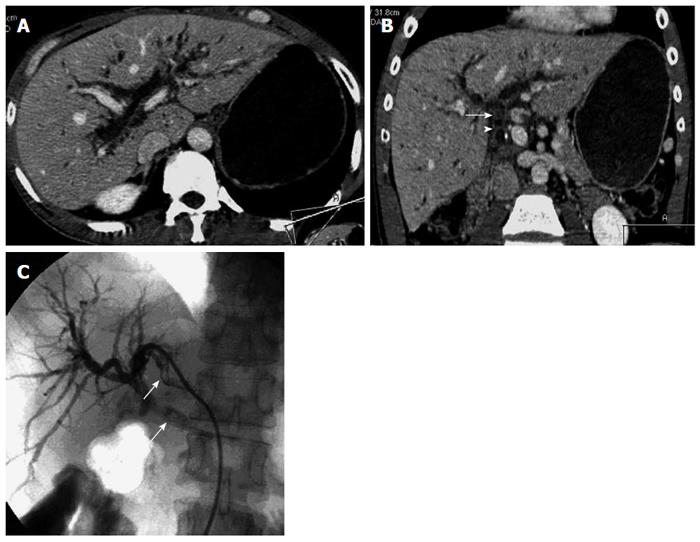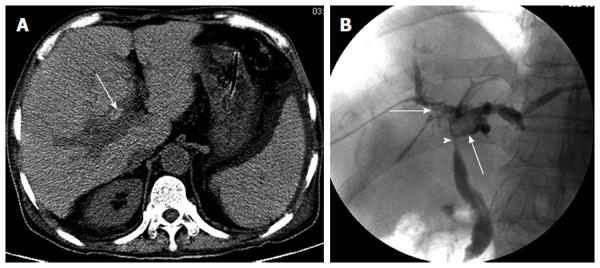Copyright
©2014 Baishideng Publishing Group Inc.
World J Gastroenterol. Sep 7, 2014; 20(33): 11856-11864
Published online Sep 7, 2014. doi: 10.3748/wjg.v20.i33.11856
Published online Sep 7, 2014. doi: 10.3748/wjg.v20.i33.11856
Figure 1 A 36-year-old man with obstructive jaundice due to anastomotic biliary strictures 5 mo after orthotopic liver transplantation.
Computed tomography oblique reformat images (A, B) display biliary dilation at the intrahepatic and hepatic hilar bile ducts, biliary stone (arrow) and anastomotic strictures (arrowhead); C: Percutaneous transhepatic cholangiography demonstrates biliary dilation, anastomotic obstruction, and filling defect (arrow) in the common bile duct and the left hepatic duct which caused by biliary stone or sludge.
Figure 2 A 66-year-old women with obstructive jaundice due to nonanastomotic biliary strictures 11 mo after orthotopic liver transplantation.
A: Transverse computed tomography (CT) image on the portal venous phase shows marked stenosis of the hepatic hilar bile duct (arrow) and dilation of the intrahepatic bile ducts; B,C: CT oblique reformat image shows biliary stenosis at the hepatic bifurcation (black arrow) and the donor common duct (white arrow); D: Percutaneous transhepatic cholangiography demonstrates the stenosis of intrahepatic bile duct and hepatic bifurcation (white arrow), and complete occlusion of the donor common duct (black arrow).
Figure 3 A 57-year-old man with jaundice due to biliary stones and anastomotic biliary strictures 13 mo after orthotopic liver transplantation.
A: Transverse plain computed tomography image shows a high-density focus at the hepatic hilar region (arrow); B: Percutaneous transhepatic cholangiography demonstrates filling defect (arrow) caused by biliary stone or sludge in the hepatic hilar bile ducts, and anastomotic biliary strictures (arrowhead).
Figure 4 A 32-year-old man with fever due to anastomotic bile leakage 12 d after orthotopic liver transplantation.
A: Transverse computed tomography image in the portal venous phase shows a bulk of fluid collection at the hepatic hilar region (arrow); B: Percutaneous transhepatic cholangiography demonstrates anastomotic bile leakage.
Figure 5 A 46-year-old man with jaundice and fever due to biloma or biligenic hepatic abscess 4 mo after orthotopic liver transplantation.
Transverse computed tomography (CT) image in the portal venous phase (A) and oblique reformat image (B) show multiple biloma or biligenic hepatic abscess (white arrow) communicating with the dilated bile ducts (black arrow), and stenosis of the hepatic hilar bile duct (arrowhead); C: Percutaneous transhepatic cholangiography demonstrates biliary dilation, necrosis, and abscess cavity (contrast medium pool) (arrow); D: CT angiography shows hepatic arterial anastomotic stenosis (arrow).
- Citation: Meng XC, Huang WS, Xie PY, Chen XZ, Cai MY, Shan H, Zhu KS. Role of multi-detector computed tomography for biliary complications after liver transplantation. World J Gastroenterol 2014; 20(33): 11856-11864
- URL: https://www.wjgnet.com/1007-9327/full/v20/i33/11856.htm
- DOI: https://dx.doi.org/10.3748/wjg.v20.i33.11856













